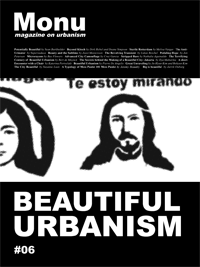Aqui es Tijuana en MONU -Magazine on Urbanism
 Monu is a newly founded magazine on urbanism based in Rotterdam, New York City, Berlin and Kassel. Monu will be a forum for young writers, designers, photographers etcthat are working on urban topics
Monu is a newly founded magazine on urbanism based in Rotterdam, New York City, Berlin and Kassel. Monu will be a forum for young writers, designers, photographers etcthat are working on urban topics
Acaba de salir una reseña de Aqui es Tijuana/Here is Tijuana en una revista de urbanismo con representacion en Rotterdam, Nueva York, Berlin, y Kassel – escrita por Jason Rebillot maestro en la Universidad de Colorado, facultad de arquitectura. En Diciembre visite a Rebillot en Denver para le presentación final de su taller de diseño – Border Studio.
by Fiamma Montezemolo, Rene Peralta, and Heriberto Yepez
Here is Tijuana presents a graphical and textual analysis of the
Mexican city of Tijuana, which sits tightly against the U.S. border
and the city of San Diego. This transnational ‘metroplex’, bisected
by a 10-ft. high steel wall, has emerged in recent years as an urban
research laboratory for many academics and practitioners on both
sides of the border; of particular interest to them are the immediate
socio-economic, political and ecological tensions and exchanges
across the wall. For this reason, a multi-disciplinary triad of coeditors
initiated this project as an anthropologist (Montezemolo),
an architect (Peralta) and a writer (Yepez). Although focusing primarily
on Tijuana and its morphological and procedural modes of
operation, the book never strays far from the discourse surrounding
the complexity of economic and cultural exchanges between the
city and its neighbor to the north.
Photographs, statistics, artwork, and literary fragments comprise
the majority of the book’s content. Organized according to three
geographic themes (Avatars, Desires, and Permutations), Here is
Tijuana attempts to present the city in a light other than that of the
predominant view, which has been informed largely by a recent
history of drugs, violence, alcoholism, and prostitution. The three
co-editors do not, however, ignore or deny this history; rather, it is
presented as one of many layers to be read in decoding the mechanisms
behind the reality of Tijuana. Intrinsic to this layered system
is a focus on the dual role of the city as both a springboard for Latin
America’s immigration to the United States and a collection pointand
eventual permanent residence- for many who lack either the
means or the desire to cross the border.
With the opening chapter, Avatars, the immediate border crossing
between Tijuana and San Diego is brought to the forefront, illuminating
the particular socio-economic rationale behind the busiest
international border crossing in the world. The mythological
underpinnings surrounding the pursuit (often times via dangerous
and illegal border crossings) of higher wages and better living conditions
in the U.S., is placed in parallel to another segment of the
immigrant population of Tijuana, many from the interior of the
country. These workers seek employment not across the border,
but in one of the many foreign-owned maquiladoras, or factories,
along the south side of the wall, which offer signifi cantly depressed
wages and diffi cult working parameters to their employees. This
duality between transience and permanence defi nes in many ways
the ambiguous character of Tijuana. Desires addresses the darker
side of Tijuana’s history- and contemporary conditions- by exposing
the workings of the city’s red-light district. Again, a certain
economic rationale underlies the perpetuation of this not-so-hidden
informal trade. Lastly, Permutations articulates (in reverse geographic
order) the morphological and urbanistic evolution of
Tijuana’s formal organization, working from the newer, sprawling
areas inland to the historical core closer to the coast of the Pacifi c
Ocean. Specifi cally, this chapter positions a higher-density core of
Tijuana against serial housing deployments to the east that mimic
the organizational logics of American housing developers in Southern
California, with the latter conscripted in part to accommodate
the tremendous number of recent arrivals to Tijuana.
The structure of Here is Tijuana, as the editors point out in their
introduction, is ‘analogous to the city’ itself- layered, multifaceted,
vibrant, and occasionally elusive. Perhaps herein lies a major
strength of the book. With the presence of three disciplinary voices
selecting and soliciting material from an even wider angle of perspective,
a rather comprehensive analysis of the city emerges.
Additionally, the editors make clearly evident the often contradictory
and unreliable nature of the data collected- again allying the
book’s content with the fragmented identity of the city that it mirrors.
Lastly, the book presents a portrait of a transnational urban
condition that has received a heightened sense of awareness in
the post-September 11th era. The book’s engagement with larger,
topical discussions concerning security, identity, nomadism, and
tourism recommends Here is Tijuana to an audience beyond mere
design communities.
Jason Rebillot is a Senior Instructor in Architecture at the University of
Colorado (Denver/Boulder, USA)
